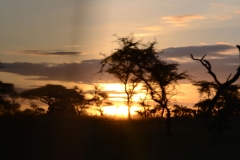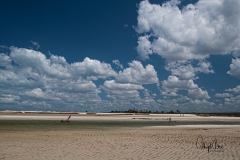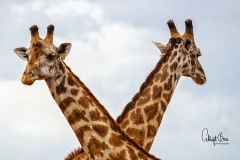











The town of Bagamoyo is the oldest town in Tanzania, founded by the end of the 18th century. It was the original capital of German East Africa and one of the most important trading ports along the East African coast. Today the town has circa 30,000 inhabitants and is the capital of the District of Bagamoyo, recently being designated as a world heritage site.
Location: Bagamoyo is located at 6°26′S 38°54′E. It lies 75 km north of Dar-es-Salaam on the coast of the Indian Ocean, close to the island of Zanzibar.
History: Bagamoyo’s history has been influenced by Indian and Arab traders, by the German colonial government and by Christian missionaries. About 5 km south of Bagamoyo, the Kaole Ruins with remnants of two mosques and a couple of tombs can be dated back to the 13th century and show the importance of Islam in those early Bagamoyo times. Until the middle of the 18th century, Bagamoyo was a small and insignificant trading center where most of the population were fishermen and farmers. Main trading goods were fish, salt and gum among some other things.
In the late 18th century Muslim families settled in Bagamoyo, all of whom were relatives of Shamvi la Magimba in Oman. They made their living by enforcing taxes on the native population and by trading in salt, gathered from the Nunge coast north of Bagamoyo. In the first half of the 19th Century, Bagamoyo became a trading port for ivory and slave trade, with traders coming from the African interior, from places as far as Morogoro, Lake Tanganyika and Usambara on their way to Zanzibar. This explains the meaning of the word Bagamoyo (“Bwaga-Moyo”) which means “Lay down your Heart” in Swahili, as the slaves were shipped by dhow to Zanzibar and never saw their home country again.
Slave trade officially ended in the year 1873, but well into the end of the 19th century, slaves were sold and traded in Bagamoyo.
In 1868, Bagamoyo’s Muslim’s presented the Catholic “Fathers of the Holy Ghost” with land for a mission north of the town, the first mission in East Africa. This caused resistance by the native Zaramo people which, after intervention by the French consul in Zanzibar was put down by Sultan Majid and after 1870 by Sultan Barghash. Originally the mission was intended to house children who were rescued from slavery, but it soon expanded to a church, a school, and some workshops and farming projects.
But Bagamoyo was not only a trade center for slaves, ivory and copra, it was also a starting point for some renowned European explorers. From Bagamoyo they moved out to find the source of the River Nile and explored the African inner lakes. Some of these were David Livingstone, Richard Francis Burton, John Hanning Speke, Henry Morton Stanley and James Augustus Grant.
Bagamoyo was the German headquarters of German East Africa in 1891. In the first year of World War I, a British air attack and naval bombardment was launched on Bagamoyo, the Germans overrun and the German garrison taken.
When Seyyid Said, Sultan of Oman, decided to move his capital from Muscat to Zanzibar in 1940, Bagamoyo’s importance began to decline.
Getting there: About 1 -hour drive from Dar es Salaam.

Kilwa Kisiwani was once the most famous trading post in East Africa. In 9th century the Swahili wealth owner of the island sold it to a trader called Ali bin Al-Hasan, the founder of Shiraz Dynasty. From 11th Century to early 15th Ali bin Al-Hasan managed to create a powerful city (Kilwa Kisiwani) and as major trading center along east African coast. He built a great mosque, established close trading links to interior of southern Africa as far as Nyasaland and Zimbabwe.
In this sense , Kilwa Kisiwani became the principle trading port on the Indian Ocean. Its wealth came from the exchange of gold and iron from Great Zimbabwe and other part of Southern Africa, ivory and slaves from mainland Tanzania with textiles, Jewelry, porcelain and spices from Asia.
By the 13th Century Kilwa had become the most powerful city on the East African Coast, exercising political and trading domination as far as Pemba Island in the north and Sofara (the modern Beira in Mozambique) in south . It is the offshore location and the tidal currents that isolate the island from the mainland protected them from landslide attack.
The outside world came to know Kilwa through a Moroccan intellectual travel {Abu Abdullah Ibn Batuta} who had visited Kilwa in 1331, and the Portuguese sailors who visited the place about 170 years after Batuta, these travelers are credited with much of the Kilwa’s Written History:- about the life, wealth and powerful trade control on East African Coast. When Abu Abdullah Ibn Batuta, arrived at Kilwa, he was amazed with its beauty.

The name Pangani owes to the river that runs through northern part of this Historical Town. Pangani is an ancient town, and is believed to have been established before the 6th Century BC and played an important role during the slave trade era. It was a trading port dealing mainly with slaves and ivory. Several historical sites in and around the town serve as reminders for the strong Arabic influence and the later German, British colonial era in Tanganyika
Nowadays it is mainly a fishing town dotted with coconut trees, providing beautiful beaches for quiet vacation. Pangani is situated about 50km south of Tanga on the mouth of River Pangani that flows from the slopes of Mt. Kilimanjaro.
In and Around Pangani
The Old Boma a two storey rectangular Boma constructed in 1810 was the residence of a wealthy Omani trader who was responsible for erecting the Coral rag wall at the ferry jetty. Legend has it that several slaves were buried alive under the pillars, which was supposed to ensure strong foundations. The former British Hospital was built in 1918 and subsequently served as a jail. Behind this double-storey building, you will find two cemeteries appear to date back to the 17th and 19th Centuries. The 17th Century cemetery has Portuguese graves and the 19th German. On the waterfront, there are two significant buildings. The Castellated double storey was the Slave depot and the German Customs House. Across the ferry at Bweni, stand the remains of a German Fort built in 1916 to repel the British naval invasions. There is also a commemorative pillar dedicated to Christian Luutherborn. Back on Pangani town side of the ferry, at a place called Muhembo one can see the Shirazi Mosque, which is larger than the one at Tongoni ruins but is much poorly preserved.
Pangani River Cruise
A subtle way to rejuvenate your senses, a point where you can see the river and the sea meet, where hippos and crocodiles lurk and fishermen reel in their days catch. The stunning scenery and never ending coconut plantations with a lovely sunset over the river, makes a very relaxing end to the day with sundowners and snacks.
Maziwe Island
Maziwe Island Marine Reserve: A breath taking island and a boat trip not to be missed. Idyllic for swimming, snorkelling, diving and sunbathing. It is situated 10kms off shore from Pangani, has over 350 fish species, 35 genera of coral and an abundance of shoreline birds. Maziwe Island was also the most important nesting site on the Tanzanian coast for Sea Turtles. Picnic breakfasts and seafood BBQs can be arranged on the island.
Amboni Caves
The caves being only 6.5kms from Tanga town and probably the most extensive cave system in East Africa are certainly most impressive. With our Caretaker/Guide and torches, we enter caves 3a and 3b, which offer a combined 750m of accessible passages. After about 50m we enter into a magnificent 15m high chamber overhung with huge stalactites. From this chamber we walk through several narrow passages and large caverns as we pass several impressive natural sculptures. The main Amboni cave has a spiritual significance to the Digo people. Mabavu is the name of a deity and the chamber associated with Mabavu is called Mzimuni where you will find scattered bones, food and other gifts.
Tongoni Ruins
Tongoni means ‘Place of Ruins’. In 1498, the famous Portuguese explorer Vasco Da Gama ran aground at Mtangata village adjacent to Tongoni. The main point of interest is the 40 tombs which are the largest such concentration in East Africa.
Amani Forest Nature Reserve
Offers a combination of excellent walking, a beautiful forest and animal life. It is still the second largest Botanical Garden in the world. You will encounter a wide variety of birds as well as black and white colobus and blue monkey. You could even be lucky and catch sight of the bizarre Zanj elephant shrew. Not forgetting the African violet plant.

The Kondoa or Kolo Rock Paintings are a series of caves carved into the side of a hill looking out over the steppe, approximately nine kilometres east of the main highway from Kondoa to Arusha, about 20 km north of Kondoa, in Tanzania. It is a world class historical heritage site, an ancient rock art are remarkable not just for their quantity and quality, but for their astonishing time span, – million years ago.
The caves contain paintings, some of which are believed by the Tanzania Antiquities Department to date back more than 1500 years. The exact number of rock art sites in the Kondoa area is currently uncertain, however, estimates are of between 150 and 450 of the decorated rock shelters.[1] The paintings depict elongated people, animals, and hunting scenes.
One will get an experience of exploring the Kolo rock paints and discover many other rock paint sites in the area. The rock paints are scattered almost all over the Kondoa district. One can arrange to explore the rock paints for up-to five days consecutively.

STONE TOWN (Historical place)
The historically, culturally and architecturally important capital town of Zanzibar Island is a World Heritage Site. The narrow lanes snake between over 2,000 buildings where shops, Internet-cafes, market stalls and restaurants vie for space with various monuments and structures of cultural pride. Along this variegated skyline are paraded some of the most impressive building to be found on the islands, all over locked by the Lock Tower atop the House of Wonders.
After clearing immigration, one wanders out of the Port Authority and turns right into Mizingani Road. The first of the wonderful buildings one passes is the grand, four-storey Old Dispensary with its particularly decorative balconies. Located opposite the new port buildings, the dispensary was built in the 1890s.
A little further along the Mizingani Road, the Palace Museum (Beit-al Sahel) was originally built and served as the official residence of the Sultan of Zanzibar until January 12th 1964, when the dynasty was overthrown in the people’s Zanzibar Revolution. It serves as a museum devoted to the era of the Zanzibar sultanate..
Outside the museum is the Makusurani graveyard where some of the Sultans were buried. Lying just south of the Palace Museum, The House of Wonders (Beit-al-Ajaib) was formerly the palace of Sultan Barghash. It gets its name from the fact it was the first building in Zanzibar to have electricity, and the hundreds of light bulbs glowing at night must have made it truly a wondrous house.
Next to Beit-al-Ajaib and occupying the site of an old Portuguese Chapel, is The Old Fort. The Abusaidi family of Omani Arabs, who had built this massive structure in the 1700s. In recent years it has been partially renovated to house the Zanzibar Cultural Centre. In an inner courtyard lies a stone-built amphitheatre that hosts performances of local music and dance, such as Taarab, Zanzibar’s most popular form of music.
The oldest Christian Church of its kind in East Africa, the Cathedral stands on the site of the public slave market, on the eastern side of Stone Town. It was constructed by the Universities Mission in Central Africa (UMCA) in 1877 when the slave trade was abolished. Outside there is a life-like stone statues of male and female slaves, attached with iron shackles and chains, stand in a pit symbolising not only their inhumane incarceration but also depth of their despair.
Just outside Stone Town, to the northeast along Malawi Road, stands Livingstone House. Sultan Said Majid, who ruled Zanzibar and Tanzania’s coast from 1856 to 1870, built it around 1860.
The fruit and food market, built in 1904, is about halfway along Creek Road (now renamed Benjamin Mkapa Road) and is a good place for shopping and sightseeing. It is an attractive place full of fresh farm produce, but the most evocative products are the scented spices and seafood.
Built by sultan Said Barghash in the late 19th century, the Hamamni Persian Baths were the first public baths in Zanzibar. Although they are no longer functioning, they are maintained in near-perfect condition.
The old Peace Memorial Museum (Beit el Amani) contains exhibits and records which make up the rich history of Zanzibar, from the early days of the Omani Sultans and the British colonial period right up until independence. The museum also contains Dr. David Livingstones’ memorabilia, as well as the drums used by the Sultans and a priceless collection of the lithographs, maps and photographs dating from the 19 th and early 20 centuries.

Olduvai Gorge is an archaeological site located in the eastern Serengeti Plains. The gorge is a steep sided ravine roughly 30 miles long and 295 ft. deep. Exposed deposits show rich fossil fauna, many hominid remains and items belonging to the one of the oldest stone tool technologies. The time span of the objects recovered date from 15,000 years ago to over 2 million years ago.
In 1959 the skull of zinjanthropus was discovered by Dr. Leakey at the Olduvai Gorge. zinjanthropus is believed to have lived 1.8 million years ago. In the 1970’s the foot-prints of animals and early hominids dating back to 3.5 million years were found by Mary Leakey at Laetoli, some 45 kms south of Olduvai Gorge.
In 1974 fossils of hominid tooth were discovered, dating back to 2.4 million years. Engaruka Site, discovered not very far from Olduvai is believed to be an ancient settlement of a later civilisation. Between half a million and a million years ago, “Homo Erectus” , who stood upright, wondered around making use of hand axes. Many such tools were found at Olduvai.
Skeletal remains of hominids on the oldest bed of the gorge are assigned to the Homo Habilis an Australopithecus Boisei families. Campsites and what is believed to be a butchery site have also been excavated from this bed. The Hominid living sites in Bed I are found mainly where streams from the volcanic highlands carried fresh water to Olduvai lake. The conditions for the preservation of the sites is mainly due to the ash falls from the nearby volcanoes. The debris found at the sites are various tools, bone and teeth from animals, mainly from fair sized antelopes. Also a loosely built circle of lava blocks was found, suggesting that crude shelters were formed here as well.
The latest of the archaeological Beds is the Naisiusiu. It lays in the bottom of the Gorge at what is now the present depth. It only has a depth of 33 ft. It contains one site that has microlithic tools and one complete Homo Sapien skeleton, both of which date to 17,000 years ago.
More than 150 different species of extinct mammals have been identified from the fossils, as well as many birds, reptiles, amphibians and fish. An on-site museum explains the archeological significance of the discoveries. This area, it seems, is indeed the “Cradle of Mankind”.